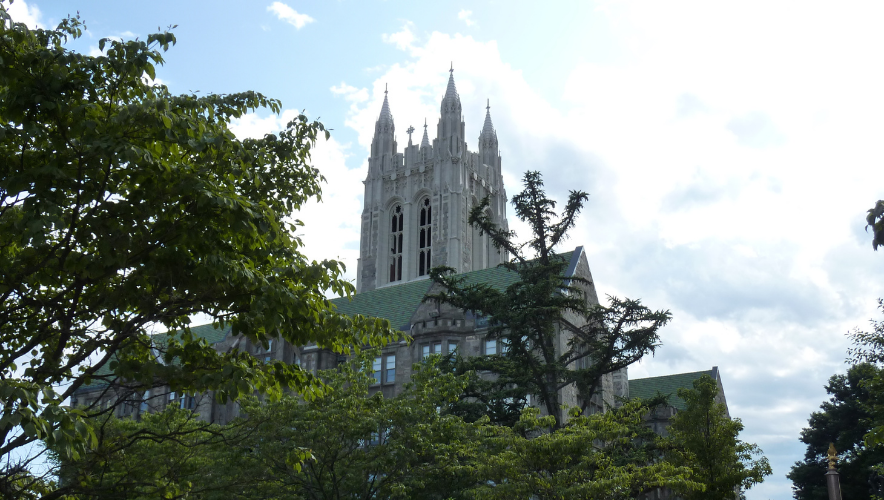This is a reposted article from AAAS News; read the original here.

Boston College School of Theology and Ministry is among the eight institutions joining the newest cohort of AAAS’ Science for Seminaries. | Jim McIntosh/Flickr CC0 1.0
Eight seminaries across the country will incorporate science into their coursework and campus life as participants in the American Association for the Advancement of Science’s Science for Seminaries project.
The seminaries are the Academy for Jewish Religion, Boston College School of Theology and Ministry, Methodist Theological School in Ohio (MTSO), Palmer Theological Seminary, Portland Seminary, Saint Meinrad Seminary and School of Theology, Trinity Evangelical Divinity School and University of Dubuque Theological Seminary.
The eight new institutions bring the total number of seminaries that have participated to 42, reaching thousands of seminary students since the project’s launch in 2014. The new participants represent a range of religious traditions, with the Academy for Jewish Religion joining as the program’s first non-Christian seminary. Other new participants represent traditions including Roman Catholic, United Methodist, Baptist, Interdenominational, Evangelical Free Church and Presbyterian.
Science for Seminaries is a project of the AAAS Dialogue on Science, Ethics and Religion (DoSER) program in partnership with the Association of Theological Schools (ATS), provides participating institutions with resources to integrate science into their coursework and campus-wide events over the next 18 months. The goal is to foster a positive understanding of science among future religious leaders and to encourage informed dialogue on scientific topics among those leaders and their congregations. The project is funded by the John Templeton Foundation.
CONNECTING SCIENCE AND SEMINARIES
“Science and technology impact every area of modern life, and many religious communities are eager to incorporate good science into their teaching and service to society,” said Jennifer Wiseman, DoSER program director. “By connecting scientists with seminary leaders, seminary students become better prepared to welcome current and relevant science into their future congregations,” she said.
More than three-quarters of Americans identify as members of a religious group, according to data from the Pew Research Center. Yet only a small fraction of students pursuing an advanced degree from a seminary hold undergraduate degrees in the sciences, according to an ATS survey.
“The idea for the project was simple: how can we help religious leaders better understand modern science, and how can we do it in a way that affirms a healthy dialogue between and among scientific and religious communities? The goal of Science for Seminaries was to create a project where seminary professors felt supported, pedagogies were strengthened, and seminaries could tailor the project to fit the needs of their particular community,” said John Slattery, DoSER senior program associate.
THINKING BEYOND THE TEXT
At MTSO, participating in Science for Seminaries aligns with the school’s efforts to help seminarians “think beyond the text,” said Elonda Clay, director of the school’s library. Part of fostering growth and preparing seminarians for their work is helping them respond to the challenges of the day, added Clay.
Offering seminarians grounding in scientific topics “would free them up to be more open to learn, to be in dialogue and to include other voices,” said Clay.
“How do you use the science to be a more effective leader and a more effective clergy person?” added Ora Horn Prouser, chief executive officer and academic dean of the Academy for Jewish Religion.
The participating seminaries will draw upon resources – including the Science: The Wide Angle video series, syllabi from earlier participants and a virtual curriculum meeting where faculty members and administrators from each of the institutions can learn and collaborate – to help them incorporate scientific topics ranging from evolutionary biology to neuroscience to cosmology to artificial intelligence into their core curricula.
“This project has built an appreciation of how scientific understanding can contribute to and expand the exploration of anthropological, epistemological and ethical questions,” said Curtis L. Baxter III, DoSER senior program associate.
CHARTING NEW COURSES
At MTSO, for instance, a new course module on pandemics and Christianity will incorporate a timely scientific topic and thousands of years of religious history, said Clay. The course will encompass how pastoral care and worship have been affected by historical pandemics, offering examples from the past and seeing how they might inform seminarians today, amid the COVID-19 pandemic, she noted.
The course, like many others planned by other participants, will include scientists in the course development and in the teaching. MTSO plans to bring in virologists and public health experts as guest lecturers to address topics such as vaccine misinformation, Clay said.
At the Academy for Jewish Religion, one of several planned new courses will bring scientists in conversation with Biblicists, said Prouser. “Science and Biblical Imagery” will deepen students’ understanding of theology by providing scientific context. For instance, a biblical passage likening children to olive saplings is deepened by knowing how olive trees grow, Prouser said. Olive branches circle around the stem as they grow, so children who are like olive branches grow up to revolve around their families, she said.
EXPANDING THE CONVERSATION BEYOND THE CLASSROOM
In addition to incorporating science into core coursework, Science for Seminaries will also support institutions as they plan public events about science and religion. The planned symposia, lectures and book clubs are intended to expand conversations about science and religion beyond the seminary to include community members as well.
Seminaries are also taking other creative approaches to encourage their students to continue to incorporate science into their work beyond the classroom walls. For the next 10 years, the Academy for Jewish Religion will offer an award at ordination for the best sermon by a seminarian that integrates mainstream science into its message, said Prouser.
“I think this is going to become a big topic of conversation at our school, and that’s very exciting,” she said.




